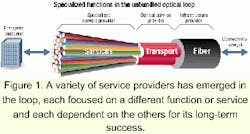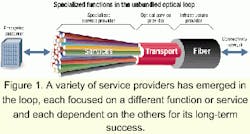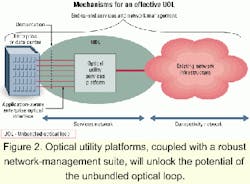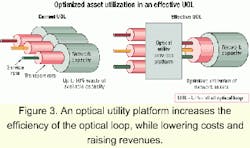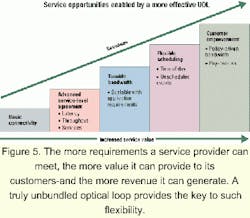Toward an efficient unbundled optical loop
A variety of service providers will benefit from the development of an optical utility services platform.
Solomon Wong, Akara Corp.
Enterprises are continually challenged to meet growing IT demands, while striving for greater efficiencies, thereby forcing enterprises to request higher-value network services for business-critical applications. To address this pent-up demand, service providers can shift their focus from building optical bandwidth and providing basic connectivity to leveraging the installed asset base to unleash an entirely new class of high-value, high-growth optical data services. Alternatively, this enormous opportunity enables a new type of specialized service provider, which focuses specific core competencies to create high-value network services, while leveraging the resources of existing service providers, thus signaling the emergence of the unbundling of the optical loop.
To leverage the existing optical network to deliver these high-value, high-growth services, the network will evolve to provide end-to-end service management. It must provide the advanced capabilities required for the enterprises' business-critical applications. And to be truly efficient-compelling cost-efficiencies and steady profitability-the network will evolve to support the unbundled optical loop (UOL), where multiple service providers will drive the proliferation of advanced optical services to a mass market and support sustainable business models.
An enormous services opportunity lies in the medium-to-large enterprise market, where over the past few years demand has grown exponentially for optical bandwidth to support business-critical delivery of such services as storage networking, content distribution, and video.
Looking forward, the Dell'Oro Group forecasts LAN traffic will continue to double annually. International Data Corp. (IDC) calls for an annual doubling of storage traffic. A Business Communications Review user survey estimates that 70% of servers will be connected with Gigabit Ethernet by the end of 2002. And IDC forecasts that 500,000 Fibre Channel links alone will require extension into the MAN/WAN through 2003. Moreover, enterprise IT requirements continue to escalate, especially for instantaneous, "zero-loss" applications that support the rising corporate dependence on internetworking and immediate information exchange across organizational, technical, and geographical boundaries. In this environment, corporate IT managers face the challenge of supporting cost-effective, secure, business-critical information exchange over multiple locations and among users, customers, suppliers, and others in the business value chain. Complicating these challenges is the scarcity of employees able to manage complex systems requirements. Morgan Stanley Dean Witter projects that unfulfilled IT jobs are expected to reach four million by 2003 (Equity Research, November 2000).
By year-end 2000, according to Pioneer Consulting, $30 billion was invested in North American metropolitan and long-haul optical networks. This build-out has created an unprecedented amount of available bandwidth, which has begun to address the challenges faced by corporate IT managers tasked with supporting business-critical applications that require gigabit-per-second rates of information exchange and optical network interfaces such as Gigabit Ethernet and Fibre Channel.However, despite vast quantities of available bandwidth and despite insatiable market demand for that bandwidth, less than 5% of enterprise customers currently utilize or have access to optical services. ("Optical services" are defined as enabling customer-premises equipment to optically connect directly into the service provider's optical network.) The limited ability of today's optical infrastructures to convert the rich stores of bandwidth into an outflow of new advanced services is creating an optical services bottleneck.
Leveraging the tremendous amounts of bandwidth to support existing (best-effort Internet protocol and voice) and emerging (business-critical data-networking) services through effective access to bandwidth remains a challenge.
To accommodate current networking applications and plan for future requirements, many enterprises are utilizing outsourcing strategies in which third parties procure, troubleshoot, maintain, and scale functions in the data center. In fact, Gartner Group forecasts that 65% of enterprises will utilize outsourcing by 2004.
This trend has spawned a new category of specialized service providers (xSPs), focusing on areas such as storage (SSP), hosting (HSP), Internet access (ISP), Ethernet (Ether SP), and business applications (ASP). In turn, many of these xSPs outsource their network connectivity requirements to another type of provider, the optical service provider (OSP), which specializes in operating optical connectivity networks. Both incumbent carriers and emerging startup service providers serve this market. Some OSPs lease physical fiber plant from fiber infrastructure providers (FIPs), reducing time-to-market and enabling a focus on network integration, operations, and service delivery (see Figure 1).
Not surprisingly, each of these carriers has a different business model. For example, the FIPs focus on negotiating access to and managing right-of-way, installing conduit, purchasing and pulling fiber through the conduit, then leasing the fiber to generate revenues. The FIP adds value to the industry model by offloading from service providers direct investments in capital, time, and other resources to build-out fiber plant, freeing service providers to focus on time-to-market for new services. Critical to the success of an FIP business model are stable, recurring revenues with simple parameters that can be easily billed and reconciled. Combined with relatively low operating costs, revenues cover capital outlays typically used early in the cycle to construct infrastructure.
As mentioned, the OSPs use fiber leased from FIPs to create infrastructure for network connectivity services. OSP capital spending is centered on optical equipment, constructing points-of-presence and network operating centers and architecturing back-office systems. Operating expenses come from systems designed to support data-centric customers with variable service parameters.
OSPs create value beyond basic connectivity by utilizing management levers to control the networking portion of their services. This control results in advanced service-level agreements (SLAs) that reflect true optical services support for end-to-end delivery of applications to xSPs and large enterprise customers.
Meanwhile, the business models of the xSPs are built around delivering such specialized services as outsourced storage to enterprise customers. By focusing on particular services and introducing unique skill sets, xSPs develop tailored service offerings without the burden of running a network or procuring fiber infrastructure. Capital spending is focused on the assets (e.g., storage disks) required to support customer outsourcing. Back-office systems support multiple customers and a high volume of transactions with varying service parameters. xSPs rely on OSPs to provide advanced network connectivity that supports the xSP's unique application requirements.
These dynamics are driving the emergence of a new metro optical service-provider model, in which there are three functions required to deliver an optical service: physical fiber plant, network connectivity, and specialized service. In practice, each function can be delivered individually by specialized providers or entirely by an integrated service provider such as an incumbent local-exchange carrier (ILEC).
The move to "unbundle" these functions and create distinct service opportunities is serving to "unbundle" the optical loop. Unbundling involves separating the assets that make up the optical loop (fiber cable, electronics, optics), combining them with the applications that utilize these assets, and making the resulting combinations available individually to effectively support businesses of specialized providers.In the optical loop, customer needs drive a requirement for effective collaboration among these multiple providers to support business-critical applications (storage extension, geo-server clustering, high-speed video, content distribution) and protocols (SCSI, Escon, Fibre Channel, D1 video, HDTV, Ethernet, and TDM). As well, each provider needs to manage its individual customer segments while retaining overall visibility of the network. For example, an OSP offering value-added connectivity services to an xSP must be able to track service metrics consistent with agreed-upon SLAs.
The ability to collect, correlate, and report on key service metrics in a manner usable by all stakeholders brings true service value. Moreover, requirements such as instantaneous "zero-loss" information exchange across distance, continuous system availability, and appealing service cost points are further driving the need for a specialized operations support infrastructure. This support infrastructure is required to maximize service assurance levels, in order for cooperating providers to collectively reach a wider segment of customers, offer value-added services, reduce operating expenses, and create the foundation for sustainable business.
While existing optical networks support high-bandwidth levels, they are limited in their ability to enable this effective collaboration and support advanced services through service awareness, utilize existing network assets, or ensure higher levels of application performance. These limitations are forcing an evolution beyond traditional capabilities.
To unleash the true potential of the UOL to deliver high-value, high-growth optical services that optimize price, performance, and management, the optical loop requires an incremental set of functions that:
- Improve responsiveness to network problems.
- Provide clear network accountability.
- Leverage existing optical investments.
- Optimize bandwidth utilization.
- Meet unique application requirements.
- Reduce total cost of providing services.
Delivering these intelligent functions to the network represents an opportunity to proliferate optical services to a mass market and support sustainable business models for the service providers.
To harness the collective benefits of each service provider and enable integrated functions that allow applications to be properly networked, providers require an evolution to a more efficient UOL. This greater efficiency will enable the exchange of more detailed information among specialized providers, which in turn better accommodates the unique networking service requirements of enterprise customers. The key mechanisms that enable an effective UOL include an optical utility services platform that effectively leverages existing optical infrastructure and collects client service performance and network data as well as a management system that enables service providers to exchange in real-time correlated client service and network information (see Figure 2).
Benefits of a network equipped with an optical utility services platform include:
- Improved operational economics from faster service responsiveness.
- Network accountability, by defining clear points of service demarcation.
- Lower capital expenditures by effectively leveraging existing optical-network capacity.
- Higher revenue per dollar of asset deployed by assigning bandwidth in increments required by applications.
- New revenue opportunities for service providers through advanced SLAs.
- Reduced network cost of ownership.
An optical utility services platform allows clear points of service demarcation in the optical network, enabling greater definition and more effective administration of SLAs. Critical optical services metrics include loss of signal, signal degradation, latency monitoring, and frame and/or bytes transmitted. Clear demarcation improves service economics by enabling quick isolation of network failures, leading to greater service assurance.
By assigning each service only as much bandwidth as is required, existing optical capacity can be leveraged more effectively, allowing up to 90% more revenue-generating traffic to be carried on existing optical networks (see Figure 3). An optical utility services platform enables secure bandwidth sharing across multiple customers in campus or multitenant environments, bringing more revenue per dollar of asset deployed. By improving economics, more end customers can be addressed at favorable cost points. It also allows these customers to network applications that previously may have been cost-prohibitive to support.In addition, providers can define new revenue opportunities as a result of the efficient UOL's ability to gather important network statistics. For instance, OSPs can augment basic connectivity by offering xSPs advanced SLAs such as notification services showing reduced data throughput or signal degradation. xSPs in turn can utilize this information to offer tighter SLAs to their customers (see Figure 4).
An optical utility services platform ensures support of a broad range of services (storage, Internet access, remote server connectivity, live video, content distribution), applications (disk mirroring, online transaction processing, server consolidation, geo-server clustering, multiple live video feeds), and protocols (Fibre Channel, Gigabit Ethernet, Escon, SONET, D1 video, HDTV). Service offerings can be delivered supporting multiple dynamic requirements, including flexible time-of-day scheduling, bandwidth tunable to meet individual application needs, and customer pay-per-use (see Figure 5).
A more effective UOL has a positive impact on all elements of the service provider's business case. A UOL deployed with an optical utility services platform reduces total cost of network ownership by up to 50%, allows the provider to maximize the value of its network assets and generate new revenue streams, and enables optical service delivery on a mass-market scale.
An efficient UOL drives sustainable business models for all categories of service providers as well as for their customers. For example, xSPs can focus on their core competencies of assessing, developing, offering, and managing unique services, while fostering mutually beneficial business relationships with the rest of the supplier value chain. They can also heighten long-term profitability by focusing capital on specific assets and operations directly related to revenues and by outsourcing the remainder to other specialists.
Both OSPs and xSPs derive value from an efficient UOL through new revenues and cost optimization:
- For basic connectivity revenues, OSPs can offer utility-based pricing, simplifying pricing and billing. xSPs can achieve incremental revenues by providing their customers with advanced connectivity services, including time-of-day assignment of specific amounts of upstream and downstream network bandwidth needed by different applications, processes, or time-of-day needs. xSPs also can offer service levels more closely suited to actual operational requirements and more effectively utilize assets.
- Generating key and timely networking information eliminates or dramatically reduces service recovery times, allowing for more aggressive SLAs, greater network uptime, and less requirement for surveillance and recovery personnel, resulting in new revenues, reduced expenses, and significantly reduced overall network costs.
Enterprise end-user benefits include a greater degree of choice when outsourcing services and the assurance of knowing that service levels can be maintained against the stringent demands of continuous availability. The potential for lower service price points will drive the use of optical services by the mass market, resulting in higher aggregate service-provider revenues.
To unleash a mass market for optically based networking services, the unbundling of the optical loop that is occurring today requires an optical utility services platform that enables a more effective UOL, one that enables service providers to:
- Address the price, performance, and management issues associated with current optical connectivity services.
- Accommodate unique demands of optically based networking while leveraging the existing optical infrastructure.
- Gain new revenue and operational efficiency.
A more effective UOL will set the stage for significantly reduced network cost of ownership; meet the demand for high-value, high-growth network services; and drive sustainable business models for specialized service providers, optical service providers, fiber infrastructure providers, and integrated service providers.
Solomon Wong is co-founder and chief technology officer at Akara Corp. (Kanata, Ontario). He can be reached at 613-270-9500 ext. 5005 or via the company's Website, www.akara.com.
